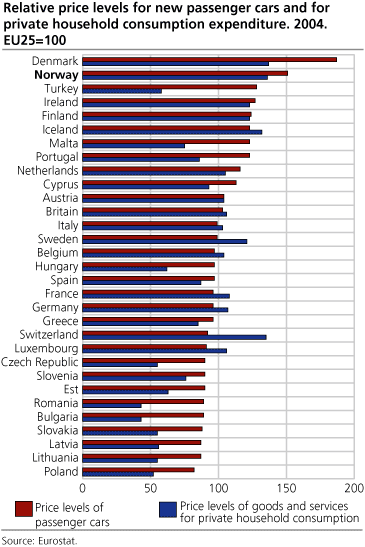Content
Published:
This is an archived release.
Car prices highest in Denmark and Norway
In 2004, the price level in Norway for new passenger cars was among the highest in Europe. Norway's relative price level was 51 per cent above the average of the 25 EU member countries (EU25) but still behind Denmark, which came out on top. Sweden stood out as the only Nordic country with a relative price level below the EU average.
The survey was carried out within the framework of the European Comparison Programme, and the Statistical Office of the European Commission, Eurostat, recently released the results. The input price data is based on list prices, including taxes.
Taxes explain some of the price difference
The relative price level varies from 18 per cent below the EU average in Poland to 87 per cent above average in Denmark. This signifies that the relative price level for new passenger cars is about twice as high in Norway and Denmark as in Poland. Finland and Iceland are also among the countries with a high relative price level, whereas Sweden is the only Nordic country that comes out below the EU average. Generally speaking, the price level for new passenger cars is a little bit lower in the EU`s new member states in Central and Eastern Europe than in the former 15 member states (EU15).
Within the EU, Denmark, Finland, Ireland, Portugal and the Netherlands have the highest taxes on new passenger cars. Norway has high car taxes as well. The price levels reflect this, but the relationship between tax and price levels is not quite clear-cut. Other possible explanations behind international price level differences are cost levels profit margins and competition, exchange rate movements and national technical requirements. For example, the car prices in the United Kingdom include the additional cost of UK specification, i.e. right-hand drive.
Relative price levels for new passenger cars and the general price and income level
The chart below shows the price level indices for new passenger cars and for the total of all goods and services for final household consumption. Comparing the two indices provides an interesting perspective. Turkey, Romania, Bulgaria, Malta, the new member states in Eastern Central Europe, as well as Portugal and Denmark, are countries where the price level of new passenger cars lies considerably above the general price level. The opposite is the case in Switzerland, Sweden and Luxembourg. Firm conclusions based on an analysis of this kind should only be drawn where the two indices deviate substantially.
If we look at the price level for new passenger cars in the context of an internationally comparable measure of income like for instance GDP per capita , Turkey, Romania and Bulgaria stand out with remarkably high price level for cars, considering their relatively low-income level. At the opposite end, the relatively high Danish and Norwegian car prices should be seen in relation to these countries' high-income levels.
Differences in technical specifications, standard equipment and discount practices are factors that complicate an international price level comparison of cars. Eurostat has tried to take account of differences in technical specifications and standard equipment, but discounts remain unaccounted for.
Read more in Eurostat s " Statistics in Focus "
The statistics is now published as Comparison of price levels in Europe.
Contact
-
Statistics Norway's Information Centre
E-mail: informasjon@ssb.no
tel.: (+47) 21 09 46 42

